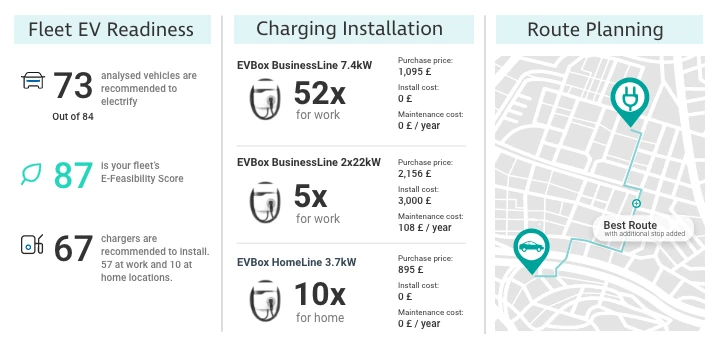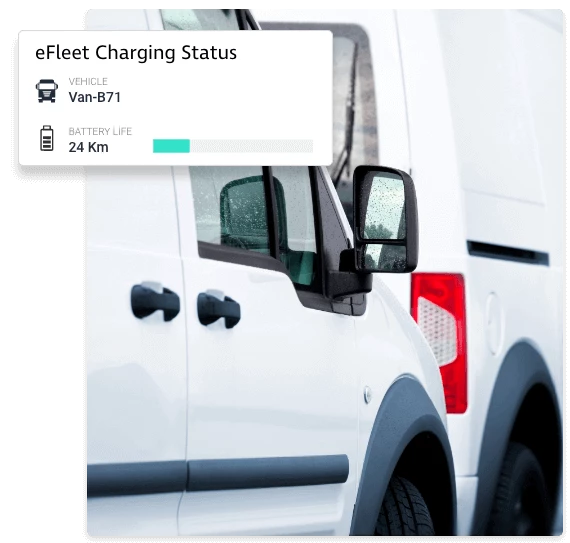Key Takeaways
Alternative fuels are revolutionizing vehicle routing. Here’s what you need to know about the impact on operators and how technology is evolving to meet the needs of mixed energy fleets.
Table of Contents
The world is gradually transitioning from fossil fuels to alternative energy sources, and industries that operate fleet vehicles are no exception. With this shift comes the need to rethink traditional operational practices, including vehicle routing.
The emergence of alternative fuels such as electricity, hydrogen (H2) and compressed natural gas (CNG) will fundamentally change how we plan vehicle routes. These changes will significantly impact owners and operators and prompt the adoption of new technologies to stay competitive in their industries.
The coming years will present challenges and opportunities as fleet operators start their transition journey and discover new ways to plan routes for mixed energy fleets, that will include both alternative fuel and internal combustion vehicles. Here’s what you need to know to prepare.
How Alternative Fuels Impact Vehicle Routing
As we transition to a future powered by alternative fuels, we must consider the changes this shift brings to vehicle routing. Factors such as the availability of refueling or recharging stations, refueling and recharging times, and the effects of weather and climate on vehicle performance will become significant considerations. While this shift is positive in terms of lowering carbon emissions, these changes present challenges that did not previously affect internal combustion engine (ICE) vehicles.
Planning for Infrastructure Availability
The accessibility and distribution of alternative fueling stations will influence route planning in various ways. Currently, the infrastructure for H2 and CNG is centered mainly around production sites and large transportation depots, which in the short term limits accessibility. Similarly, the charging infrastructure for electric vehicles (EVs) is still developing. Fortunately, EVs offer more flexibility, and businesses can install EV charging stations in more widespread locations, including depots and warehouses they own.
The availability of fuel makes route planning a more strategic process. Vehicles operating on alternative fuels will likely need to use paths with the necessary infrastructure, which could mean a shift from the traditional delivery models.
Additionally, the performance characteristics of EVs differ from ICE vehicles. Where traditional ICE vehicles operate best at consistent highway speeds, EVs are more effective at slower speeds and in stop-and-go traffic. These different characteristics may significantly impact route selection.
Weather and Climate Factors
Alternative fuel vehicles, notably electric, are susceptible to weather conditions and climate factors, influencing their performance and consequently affecting route planning. Most notably, cold weather can decrease the range of electric vehicles as the batteries provide propulsion and heating power. In freezing temperatures, EVs may need to be warmed up while charging, necessitating thorough planning and possible route adjustments.
Unfortunately, high temperatures can also impact EV performance, though usually to a lesser extent than cold weather. Further still, alternative fuels like hydrogen and compressed natural gas show less sensitivity to extreme temperatures, but severe weather events affecting production facilities or transport routes may affect availability in unpredictable ways.
Any alternative fuel routing strategy must account for these climate factors and weather conditions. In many cases, routes often need to be adjusted to ensure these vehicles achieve maximum efficiency and reliability.
Downtime Considerations
One major shift introduced when adopting alternative fuel vehicles—especially EVs—is the increased downtime for refueling or recharging. Even with the fastest charging stations available, electric vehicles still take longer to recharge than a conventional fuel tank takes to fill. Although charging times will steadily decrease with technological advancements, businesses must plan for this time.
To successfully navigate this challenge, businesses must strategically incorporate refueling and recharging into their routing and scheduling, possibly by aligning downtime with driver breaks or non-operational hours. Planning should also utilize company-owned charging infrastructure when available to avoid reliance on public chargers, which may be occupied, out of service, or otherwise unavailable. For these reasons, downtime considerations have become a fundamental aspect of vehicle route planning in the era of alternative fuels, requiring a complete rethinking of traditional practices.
Payloads and Topography
The weight of the vehicle and the elevation changes on routes can also have a significant impact on EV range, and including these factors into your charging times and locations is crucial. Tests have shown that EV’s that carry close to their maximum payload can lose nearly a quarter of their range, showing the importance of including these factors into your route plans

How Technology Can Simplify the Vehicle Routing Process
Harnessing the power of technology is paramount in orchestrating a successful shift to alternative energy vehicles. Before a fleet can adapt to new routing needs, it’s essential to understand which vehicles in the fleet are best suited for transition based on their usage patterns, routes, and lifetime costs. Advanced data analytics can delve into existing fleet data to pinpoint vehicles that can be transitioned most effectively.
Likewise, it's important to assess the infrastructure needed to support these vehicles. By mapping out existing and upcoming refueling or charging stations, and comparing them to frequent routes and vehicle performance data, businesses can anticipate and prepare for infrastructure demands. Additionally, technologies can predict where additional infrastructure might be most beneficial. This strategic planning is the bedrock for efficient route planning and ensures that the transition is seamless, guaranteeing business continuity.
When faced with these significant operational challenges, technology offers the only solution to simplify daily processes. New technologies are emerging to provide dedicated electric vehicle routing, showing available chargers and helping businesses plan their routes effectively. These solutions will be vital to ensuring that businesses continue to operate efficiently while transitioning to alternative energy vehicles.
Supporting Drivers in the Transition to Alternative Fuel Vehicles
The shift to alternative fuel may be a significant adjustment for many drivers, and it’s imperative to prioritize education and guidance during this transition. Electric vehicles have certain unique driving features, such as regenerative braking, which might be unfamiliar to those accustomed to conventional vehicles. To help drivers harness the full potential of these vehicles and ensure confidence on the road, proper training on these nuances is essential.
Additionally, the rationale behind the transition should be communicated effectively to drivers so they can appreciate the importance and benefits of the change. This will help in easing any anxieties and ensuring smooth adoption. It's also important to note that routes for vehicles powered by alternative fuels might vary from the ones they're used to. By equipping them with the right knowledge about the best routes and available charging or refueling stations, you can make their journeys more efficient and hassle-free. Supporting our drivers with thorough education and resources will not only benefit the business but will also empower the individuals behind the wheel to navigate this change with confidence.

How Alternative Fuels Will Change Transport Infrastructure
The widespread adoption of alternative fuels could also bring transformational changes to our transport infrastructure. Many businesses are exploring installing charging stations at their premises, not only for their fleet but also for public use. This proactive approach can expand the existing charging network and potentially open new revenue streams for businesses. These developments can also foster a supportive environment for EV adoption among the general public, further accelerating the shift toward alternative fuels.
On a larger scale, heavy infrastructure such as transport hubs, logistics centers and gas stations may also need to overhaul their existing setups to accommodate alternative fuel vehicles. These changes could involve installing high-capacity charging stations, creating dedicated lanes or spaces for electric vehicles, and integrating intelligent systems for efficient energy management. For these reasons, the switch to alternative fuels will usher in an era of innovation to reshape the transport infrastructure to align with more sustainable business practices.
Adapting to a New Era of Alternative Fuels with TN360
The transition to alternative fuels marks a shift for fleet operations, creating new challenges and business opportunities. However, with careful planning, proper driver training and the support of advanced technologies, businesses can navigate this transition successfully.
Teletrac Navman's TN360 platform is one platform that can help a business manage its feet today and support the transition to alternative energy vehicles. You can build a custom solution for your business in just 30 seconds and see the impact it can have in your business.

